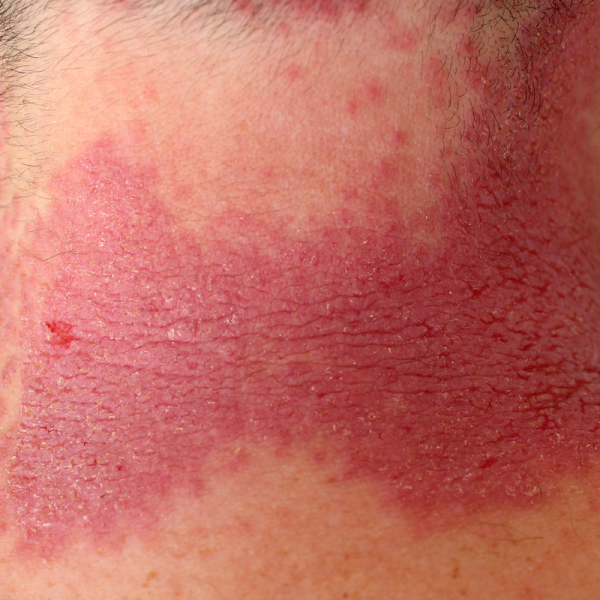
What is Darier's disease?
Darier's disease is also called dyskeratosis follicularis and describes a rare hereditary skin disease caused by a chromosomal mutation. The disease often appears on the hands and feet, the hair roots and the fingernails due to a disturbed keratinisation of the epidermis, which can be episodic and is usually less severe in winter. Darier's disease almost always appears for the first time in childhood and adolescence between the ages of 6 and 20. Males and females can be equally affected when the disease develops.
How does Darier's disease develop?
Darier's disease is an autosomal-dominant, hereditary disease. A decisive role in the development of the disease is played by mutations on chromosome 12, which contribute to the formation of a so-called calcium pump. This calcium pump distributes calcium within the skin cells. However, if there are errors in calcium distribution, this leads to the death of the skin cells.
How can a disease flare-up be prevented?
Fragrances and dyes that come into contact with the skin can be provocation factors. In addition, those affected should avoid toxic substances such as nicotine, alcohol and caffeine. It is also advised to avoid extensive sunbathing, especially at midday. When coming into contact with UV light, care should be taken to use adequate light protection.
What are the symptoms of Darier's disease?
Darier's disease is characterised by a scaly, crusty skin surface, often covered with flat, reddish papules or nodules. Some patients complain of itching, which occurs especially after sweating, contact with liquids or UV light. In addition, the following complaints are possible in connection with Darier's disease:
- bacterial infections, which can lead to an unpleasant body odour,
- brownish cornification disorders on the back of the hands and/or feet,
- pathological changes in the nails, which appear as brittleness, furrows, reddish and whitish stripes and thickening,
- Formation of whitish nodules, especially on the mucous membranes, such as the cheek and palate
The most common skin sites that can be affected by Darier's disease are therefore the following:
- the hairy area of the head,
- the so-called seborrhoeic zones, which include the face or shoulder area,
- the genital area,
- Skin folds,
- Palms and/or soles of the feet,
- Mucous membranes, whereby the palate area is particularly often affected
In general, it is advisable to consult a doctor if the skin appearance changes. This is because skin changes are always signs of a health impairment. Darier's disease can typically be identified by skin irregularities on the top of the head as well as on the face and should be clarified by a doctor at an early stage.
Is Darier's disease dangerous?
Normally, Darier's disease is not dangerous and does not tend to be complicated. Only in some cases can the rash become infected. This can involve bacteria or fungi, and in exceptional cases even herpes viruses.
How is Darier's disease diagnosed?
Darier's disease can be diagnosed by taking a medical history, but also by a clinical examination. The latter is made on the basis of papules. From a histopathological point of view, these can be the following clinical pictures:
- Papillomatosis: is noticeable by a coarsening and enlargement of the papillae of the connective tissue projecting into the epidermis. The patient perceives this as a wavy unevenness of the skin surface.
- focal, acantholytic dyskeratosis: this is understood to be premature individual keratinisation.
For a confirmed diagnosis, a tissue sample (biopsy) is taken for subsequent examination under the microscope.
How is Darier's disease treated?
If the disease is mild, keratolytic therapy to help dissolve the horny layer may be sufficient. If, on the other hand, the patient suffers from a severe inflammatory episode, this can be treated in the short term with hormones, so-called corticosteroids. If, on the other hand, the infection is bacterial, it must also be treated with antibiotics and antiseptic baths. If Darier's disease mainly affects the fingernails, antibiotics and various creams can provide relief.
If the disease is severe, retinoids can be used. Retinoids are a chemical substance that is related to vitamin A. They can also be used for dermabrasion. In addition, dermabrasion can be prescribed, in which the skin is mechanically abraded. Alternatively, skin transplantation is also possible. This is especially recommended if the disease is severe and mainly affects the axillary region.
Darier's disease primarily manifests itself through skin complaints. Reddish, itchy areas of skin may appear, and papules or pustules may also form on the skin. As these are often not perceived as aesthetic, they can be quite unpleasant for those affected, especially if they appear on the face. Especially in childhood or adolescence, Darier's disease can lead to bullying or teasing, which is why many patients feel ashamed of their disease.
If the disease remains untreated, it can cause bone changes, which in turn have a negative effect on the patient's quality of life. In summary, Darier's disease only causes complications if the disease is not treated at all. As a rule, treatment leads to a positive course of the disease.
What is the prognosis for Darier's disease?
Darier's disease has a relatively good prognosis. The disease is only noticeable externally and can be treated with medication. Possible symptoms can be completely cured through therapy. In addition, particularly severe attacks usually only occur in one season and life expectancy is not limited by Darier's disease.
